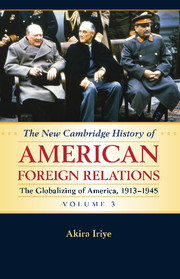Book contents
- The New Cambridge History of American Foreign Relations
- Series page
- The New Cambridge History of American Foreign Relations
- Copyright page
- Contents
- List of Maps
- General Editor’s Introduction
- Preface
- 1 The Age of European Domination
- 2 The Great War and American Neutrality
- 3 The United States at War
- 4 The Versailles Peace
- 5 The 1920s – The Security Aspect
- 6 The 1920s – The Economic Aspect
- 7 The 1920s – The Cultural Aspect
- 8 The Collapse of International Order
- 9 Totalitarianism and the Survival of Democracy
- 10 The Emergence of Geopolitics
- 11 The Road to Pearl Harbor
- 12 The Global Conflict
- Bibliographic Essay
- Index
9 - Totalitarianism and the Survival of Democracy
Totalitarianism and War
Published online by Cambridge University Press: 05 June 2013
- The New Cambridge History of American Foreign Relations
- Series page
- The New Cambridge History of American Foreign Relations
- Copyright page
- Contents
- List of Maps
- General Editor’s Introduction
- Preface
- 1 The Age of European Domination
- 2 The Great War and American Neutrality
- 3 The United States at War
- 4 The Versailles Peace
- 5 The 1920s – The Security Aspect
- 6 The 1920s – The Economic Aspect
- 7 The 1920s – The Cultural Aspect
- 8 The Collapse of International Order
- 9 Totalitarianism and the Survival of Democracy
- 10 The Emergence of Geopolitics
- 11 The Road to Pearl Harbor
- 12 The Global Conflict
- Bibliographic Essay
- Index
Summary
- Type
- Chapter
- Information
- The New Cambridge History of American Foreign Relations , pp. 134 - 151Publisher: Cambridge University PressPrint publication year: 2013



